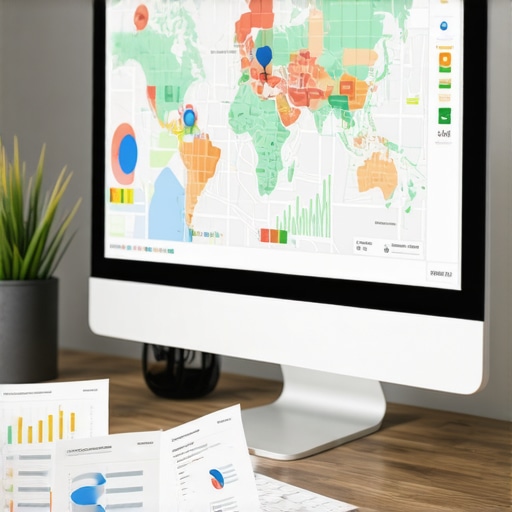Unlocking the Power of GeoGrid Tracking for Superior Maps Ranking in 2024
In the evolving landscape of local SEO, mastering Maps Rank Optimization with sophisticated GeoGrid Tracking Strategies has become essential for digital marketers aiming for dominance in 2024. As Google Places and Maps algorithms grow increasingly complex, relying on traditional methods no longer suffices. Instead, leveraging advanced geo-spatial analytics and data-driven tactics can significantly enhance local visibility, ensuring your business stands out amidst fierce competition.
Decoding the Intricacies of GeoGrid Mapping for Local SEO
GeoGrid mapping divides geographic areas into a systematic grid, allowing precise tracking of a business’s position within local search results. This technique is rooted in the principle that GeoGrid tracking enables real-time monitoring of rank fluctuations across specific coordinates, providing actionable insights that traditional keyword-focused strategies often overlook. Such granular data is invaluable for tailoring local SEO efforts to specific neighborhoods or districts.
Why Precision Matters: The Role of GeoGrid in 2024’s Competitive Map Rankings
With Google continuously refining its local search algorithms, precision in geo-targeting becomes paramount. GeoGrid tracking allows marketers to identify rank hotspots and blind spots, optimizing Google My Business (GMB) profiles, reviews, and local citations accordingly. This method supports a proactive approach, enabling rapid response to rank drops or surges and refining local SEO campaigns for maximum impact.
How can advanced GeoGrid techniques outperform traditional local SEO tactics in 2024?
Advanced GeoGrid techniques integrate machine learning and AI-driven analytics to predict ranking trends, moving beyond reactive adjustments. These strategies enable marketers to implement hyper-localized content, targeted review solicitations, and precise citation placements tailored to specific grid sections, thus elevating local map pack visibility. According to recent studies in Search Engine Land, data-driven geo-spatial analysis is transforming local SEO dynamics, making it a crucial component for 2024 success.
For further insights, explore comprehensive GeoGrid strategies and learn how cutting-edge software tools can elevate your local search performance.
Interested in refining your approach? Consider integrating state-of-the-art GeoGrid tracking tools into your local SEO arsenal and contribute your insights to the community of SEO professionals pushing the boundaries of local search mastery.
Harnessing Multi-Layered GeoGrid Data for Hyper-Localized SEO Success
As digital marketers seek to sharpen their competitive edge, understanding the multi-dimensional aspects of GeoGrid data becomes crucial. Beyond simple rank tracking, integrating layered datasets—such as demographic information, local business density, and consumer behavior analytics—can unlock unprecedented insights. These layers enable businesses to tailor their local SEO strategies with surgical precision, ensuring they target the most lucrative neighborhoods and districts.
What are the Limitations of Conventional GeoGrid Tracking in 2024?
While traditional GeoGrid tracking provides valuable positional data, it often falls short in capturing the dynamic nature of local search ecosystems. Factors such as seasonal variations, local events, and shifting consumer interests influence rank fluctuations. Relying solely on basic grid data may lead to misguided optimizations. Experts recommend supplementing GeoGrid analytics with real-time social media signals and local review sentiment analysis, as highlighted in recent industry case studies (see GeoGrid tracking strategies) for a more comprehensive picture.
How can advanced AI-powered GeoGrid analytics redefine your local SEO game in 2024?
Artificial Intelligence (AI) and machine learning extend the capabilities of GeoGrid tracking from reactive monitoring to proactive prediction. By analyzing patterns across vast datasets, AI models can forecast rank trends, identify emerging hotspots, and suggest optimal times for review solicitation or citation updates. This predictive approach minimizes wasted efforts and maximizes ROI. According to authoritative sources like Search Engine Land, integrating AI-driven geo-spatial analysis is no longer optional but essential for local SEO dominance in 2024.
For those eager to deepen their mastery, exploring advanced GeoGrid tracking techniques and leveraging innovative software tools can dramatically accelerate your local search visibility.
Thinking about the next leap? Consider how integrating multi-layered data sources with GeoGrid insights can empower hyper-localized content strategies and foster community engagement, ultimately elevating your rankings and local trustworthiness.
Mastering Multi-Dimensional GeoGrid Data for Hyper-Localized SEO Domination
In today’s fiercely competitive local search landscape, leveraging multi-layered GeoGrid datasets is no longer optional; it’s essential. By integrating demographic analytics, local business concentration, and consumer behavior insights into your GeoGrid framework, you can craft hyper-targeted SEO strategies that resonate at a neighborhood level. This multidimensional approach allows marketers to identify not only where competitors rank but also WHY they rank there, unlocking opportunities for strategic content placement, review management, and citation building tailored to specific community needs.
The Nuances of Navigating GeoGrid Limitations with Advanced AI
While traditional GeoGrid tracking provides valuable positional data, it often overlooks the intricacies of local search ecosystems, such as seasonal fluctuations, local events, and evolving consumer preferences. The integration of AI-powered analytics transforms this landscape by predicting future rank shifts and uncovering hidden hotspots. For instance, machine learning models trained on historical ranking patterns can alert you to emerging areas of interest before they become saturated, granting you a competitive edge. As Search Engine Land emphasizes, AI-driven geo-spatial analysis is revolutionizing local SEO by enabling proactive rather than reactive strategies.
What are the best practices for integrating AI with GeoGrid data to maximize local SEO impact?
To effectively harness AI within your GeoGrid system, focus on collecting high-quality, real-time data streams, including social media signals, review sentiment, and local event schedules. Employ machine learning algorithms to analyze this data, forecast rank trends, and identify optimal moments for review solicitations or citation updates. Regularly updating your models ensures adaptability to rapid market shifts, fostering an agile SEO environment that can respond swiftly to local dynamics. For a comprehensive understanding, explore case studies such as those detailed in this resource that showcase successful AI integration in GeoGrid strategies.
Interested in elevating your local SEO with cutting-edge tools? Dive into next-generation GeoGrid software solutions designed for sophisticated data analysis and predictive modeling.
The Future of GeoGrid Mapping: Merging AI, Data Layers, and Community Engagement
The future of advanced GeoGrid mapping lies in not just data but in meaningful community engagement. By combining AI-driven insights with real-world data layers—such as demographic shifts, local event calendars, and consumer sentiment—you can craft hyper-localized campaigns that foster trust and authority within communities. This holistic approach enables businesses to anticipate local trends, respond to community needs proactively, and enhance their local reputation, ultimately translating into higher rankings and increased foot traffic.
Furthermore, as local SEO becomes more personalized, integrating user-generated content and community feedback into your GeoGrid strategy will become increasingly vital. These elements serve as authentic signals to search engines, reinforcing your relevance and authority in specific neighborhoods.
Revolutionizing Local SEO with Multi-Layered GeoGrid Data Integration
As the local search ecosystem continues to evolve, integrating multi-dimensional data layers into GeoGrid tracking emerges as a game-changing approach for seasoned SEO professionals. By synthesizing demographic patterns, consumer behavior analytics, and local business density metrics, marketers can craft hyper-targeted strategies that resonate deeply within specific neighborhoods, districts, or even street blocks. This multidimensional insight not only sharpens the precision of rank tracking but also uncovers previously hidden opportunities for content optimization, review management, and citation placement.
The Impact of Real-Time Data Layers on GeoGrid Precision
Incorporating real-time data layers—such as social media activity, local event schedules, and user-generated content—into GeoGrid analysis enhances responsiveness and agility. Advanced analytics platforms enable SEO experts to monitor shifts in community engagement and sentiment, allowing for dynamic adjustments to local campaigns. For example, a sudden spike in positive reviews or a trending local event can be swiftly capitalized upon, boosting visibility and relevance in the targeted GeoGrid zones. This proactive approach surpasses traditional static tactics, ensuring your business remains at the forefront of local search results.
How do layered data enhance hyper-local SEO campaign effectiveness?
Layered data allows for a nuanced understanding of neighborhood-specific dynamics, including demographic affinities, economic activity, and cultural trends. These insights facilitate the creation of highly personalized content, tailored review solicitation efforts, and precisely targeted citation strategies. For instance, targeting areas with high young adult populations with social-centric content or focusing citation efforts in economically vibrant districts can lead to significant improvements in local pack rankings. As detailed in industry case studies published by Moz, leveraging layered datasets significantly elevates local SEO outcomes by aligning strategies with community-specific signals.
What are the practical steps for integrating multi-layered data into existing GeoGrid frameworks?
Begin by sourcing high-quality local datasets, such as demographic reports, social media analytics, and business inventories. Utilize advanced geo-analytics tools capable of overlaying these data layers onto your GeoGrid maps, enabling spatial correlation analysis. Implement machine learning models to identify patterns and predict rank fluctuations based on combined data inputs. Regularly update your datasets to adapt to evolving local conditions, ensuring your strategies stay relevant and effective. For detailed methodologies, refer to resources like this comprehensive guide on multi-layered geo-analytics integration.
Engaging with sophisticated data layering techniques will elevate your local SEO efforts, transforming raw data into actionable insights that drive tangible results.
The Ethical and Privacy Considerations in Multi-Layered GeoGrid Data Usage
While leveraging layered data offers immense strategic advantages, it also raises critical ethical and privacy concerns. Ensuring compliance with data protection regulations such as GDPR and CCPA is paramount. Employ anonymized data sources and obtain necessary consents when integrating consumer behavior insights. Transparent communication about data usage fosters trust within communities, reinforcing your brand’s integrity and authority. Experts suggest establishing clear data governance policies and regularly auditing your data practices to prevent misuse and maintain ethical standards.
Looking Ahead: The Future of GeoGrid Mapping in a Data-Driven World
The trajectory of GeoGrid mapping points toward increasingly sophisticated integrations with AI, IoT, and real-time data streams. Future developments may include predictive modeling that anticipates local search trends before they materialize, enabling preemptive optimization strategies. Additionally, the fusion of augmented reality (AR) with GeoGrid analytics could revolutionize local business engagement, offering immersive experiences aligned with community-specific data insights. Staying ahead in this rapidly advancing field requires continuous learning and adaptation, positioning your business as a pioneer in the next generation of local SEO mastery.
Expert Insights & Advanced Considerations
1. Integrating Multi-Layered Data Enhances Precision
Leveraging layered datasets such as demographic analytics and consumer behavior insights can significantly refine GeoGrid tracking accuracy, enabling hyper-localized SEO strategies that resonate with specific communities.
2. AI-Powered Analytics Transform Reactive to Proactive Strategies
Incorporating AI and machine learning into GeoGrid systems allows for predictive trend analysis, identifying emerging hotspots before competitors and optimizing efforts accordingly for sustained local dominance.
3. Community Engagement as a Signal for Search Relevance
Real-world community data, including local events and user-generated content, enhances GeoGrid insights, fostering authentic signals that boost search engine trust and ranking stability.
4. Ethical Data Usage Ensures Long-Term Strategy Sustainability
Adhering to privacy regulations like GDPR and CCPA through transparent practices safeguards reputation and maintains data integrity, which is crucial for ongoing success in layered data strategies.
5. Fusion of AR and IoT for Next-Gen Local Optimization
Emerging technologies such as augmented reality and IoT integration offer immersive, real-time local engagement opportunities, opening new frontiers for GeoGrid applications in local SEO campaigns.

